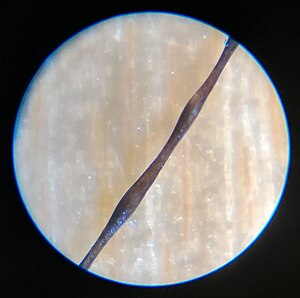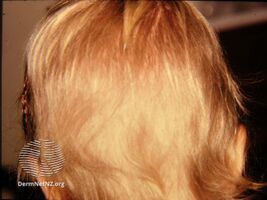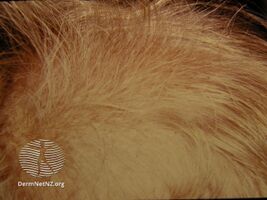Monilethrix
| Monilethrix | |
|---|---|
| Other names: Moniliform hair syndrome | |
 | |
| Beaded hair (60x magnification). | |
Monilethrix (also referred to as beaded hair)[1] is a rare autosomal dominant hair disease that results in short, fragile, broken hair that appears beaded.[2][3] It comes from the Latin word for necklace (monile) and the Greek word for hair (thrix).[4]
Presentation
The presentation may be of alopecia (baldness). Individuals vary in severity of symptoms. Nail deformities may also be present as well as hair follicle keratosis and follicular hyperkeratosis.
-
Beaded hair or monilethrix
-
Beaded hair or monilethrix
Cause

Monilethrix is caused by mutations affecting the genes KRTHB1 (KRT81), KRTHB3 (KRT83), or KRTHB6 (KRT86) which code for type II hair cortex keratins.[5] The disorder is inherited in an autosomal dominant manner.[2] This means that the defective gene(s) responsible for the disorder is located on an autosome, and only one copy of the gene is sufficient to cause the disorder, when inherited from a parent who has the disorder.
Diagnosis
Monilethrix may be diagnosed with trichoscopy.[6][7]
See also
- List of cutaneous conditions
- List of conditions caused by problems with junctional proteins
- List of cutaneous conditions caused by mutations in keratins
References
- ↑ James W, Berger T, Elston D (2005). Andrews' Diseases of the Skin: Clinical Dermatology (10th ed.). Saunders. ISBN 978-0-7216-2921-6.
- ↑ 2.0 2.1 Celep, F.; Uzumcu, A.; Sonmez, F.; Uyguner, O.; Balci, Y.; Bahadir, S.; Karaguzel, A. (2009). "Pitfalls of mapping a large Turkish consanguineous family with vertical monilethrix inheritance". Genetic Counseling (Geneva, Switzerland). 20 (1): 1–8. PMID 19400537.
- ↑ Freedberg; et al. (2003). Fitzpatrick's Dermatology in General Medicine (6th ed.). McGraw-Hill. p. 639. ISBN 978-0-07-138076-8.
- ↑ Genetic and Rare Diseases Information Center (2008-09-09). "Monilethrix". NIH Office of Rare Diseases Research. Archived from the original on 2012-07-30. Retrieved 2011-01-15.
- ↑ Schweizer J (2006). "More than one gene involved in monilethrix: intracellular but also extracellular players". J. Invest. Dermatol. 126 (6): 1216–9. doi:10.1038/sj.jid.5700266. PMID 16702971.
- ↑ Rudnicka L, Olszewska M, Rakowska A, Kowalska-Oledzka E, Slowinska M (2008). "Trichoscopy: a new method for diagnosing hair loss". J Drugs Dermatol. 7 (7): 651–654. PMID 18664157.
- ↑ Rakowska A, Slowinska M, Kowalska-Oledzka E, Rudnicka L (2008). "Trichoscopy in genetic hair shaft abnormalities". J Dermatol Case Rep. 2 (2): 14–20. doi:10.3315/jdcr.2008.1009. PMC 3157768. PMID 21886705.
External links
| Classification | |
|---|---|
| External resources |

